Welcome to our latest blog in our Schedule Risk Analysis series. So far, we’ve discussed schedule integrity and uncertainty and three-point estimating. This week we’re exploring running analysis; in particular we’re focusing on how to use Primavera Risk Analysis to do this.
How to Run Analysis Using Primavera Risk Analysis
Modelling Your Data
Once you have put in all your three-point estimates, the big question is ‘so what?’, what effect does this have on the schedule?
Primavera Risk Analysis has a powerful Monte Carlo engine behind it that can model all probabilities and give you some scenarios as to how this could affect your schedule.
Running Risk Analysis
When running risk analysis, you can either model for a set number of iterations or you have options to choose a level to converge at.
I would always suggest running at a low number of iterations initially, so you can really understand the data you are seeing before increasing this.
Once the analysis is run you can view the results in several different outputs.
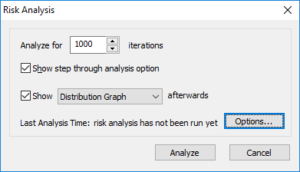
Risk Histogram
This gives you confidence level data allowing you to see the probability of meeting the deadlines on your current deterministic plan, and what confidence level you have in meeting date and cost deadlines. This can be fully customised and included in reports.
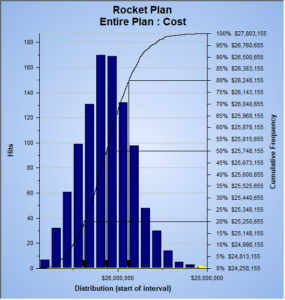
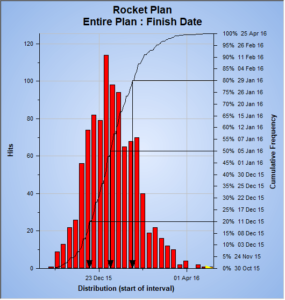
Tornado Graph
This gives you sensitivity information and shows you which activities are affecting the duration, schedule or cost the most. Based on this information, you can then put actions in place to manage the impact.
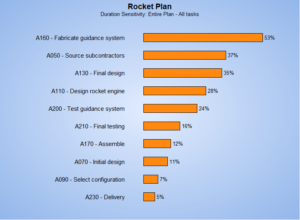
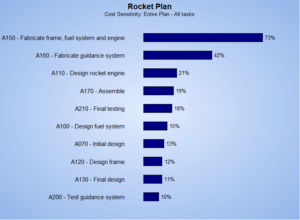
Task Percentiles
By choosing to store Risk Percentile data when running your modelling, you can also then superimpose these onto your Gantt Chart to give you ultimate visibility. This allows you to compare your deterministic schedule to different confidence level schedules.
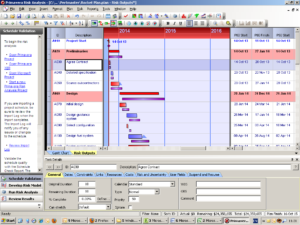
The Benefits of Running Analysis
When presenting plans to customers rather than presenting a final single figure cost and finish date estimation, it often pays to be more realistic and present a three-point estimate based on confidence levels.
Despite all the data and technology that we have access to, the reality is that it’s very difficult to accurately estimate exact finish dates and costs. Delays happen, and they can’t always be avoided.
Instead of hiding things away in extra budget or slack in activities, by working with three-point estimating and presenting on uncertainty you can be much more transparent and work more in partnership with your clients.
Tools such as Primavera Risk Analysis allow you to do this quickly and easily. You still need to understand your data and be honest with your estimates however by feeding this data in Primavera Risk Analysis you can achieve some great outputs that will allow you and your customer to have much more confidence in the outcomes of your project.
To learn more about the tool and develop your confidence in using it on your programmes, Underscore Training offer a comprehensive two-day Primavera Risk Analysis training programme. To find out more about our course please click the following link Primavera Risk Analysis. For a full list of public programme dates please see our website, Public Programme Dates.
Alternatively, if you have a group requiring training we can organise dates to suit you.
Please feel free to get in touch if you have any questions on 0203 9503730 or by email on training@underscore-group.com.
Read Next
Soft Skills: Why Being a Control Freak is Hurting Your Project Management Success
Are you a project manager who feels the need to be in control of every aspect of your project? While being detail-oriented and organised can be beneficial, it's important to recognise when your inner [...]
Project Management – the Accreditation Debate
With growing concerns about the skills gap in PM, we explore whether accredited courses are the best response to this challenge, or if they may be missing key skills that project managers need to [...]
Microsoft Project – It’s More Powerful Than You Might Think
Microsoft Project is a project planning tool that is widely used across businesses. It has a simple to use interface making it ideal for small single entity projects. Although because of this, it’s developed [...]
Understanding and Building Relationships
Whether we like it or not, we all rely on other people to get things done, and this means that the way we interact with others has a powerful impact on how smoothly our [...]
Skills for Project SUCCESS
If you’re a project manager, project success is probably the one thing you think about day in day out. More specifically, you probably worry about how you can make sure your project(s) gets completed [...]
Primavera – It’s not as scary as it sounds
Complicated, confusing and complex; those are just some of the words that often spring to mind when discussing the topic of Primavera. But is this really the case? Is Primavera as scary as it [...]






